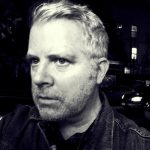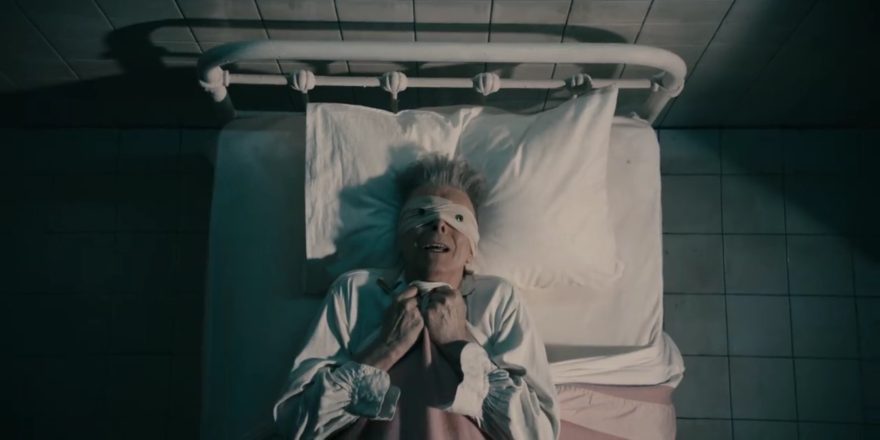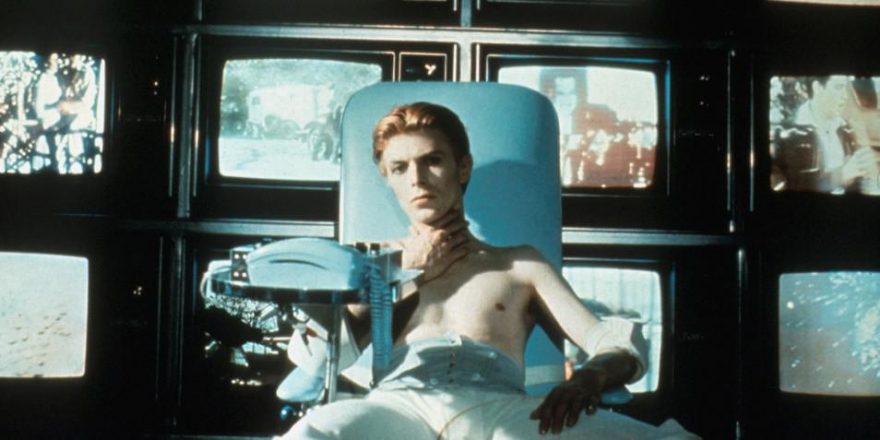In 2003, I conceived and directed for David Bowie a 30-minute film, Reality, as a companion to his album of the same name.
When Bowie died a year ago, memories of the time I spent working with him flooded back.
The following is edited from my diaries on the project, May 1 – November 13, 2003, NYC.:
I get an email from David Bowie’s manager writing that he was thinking of doing “something” with Bowie, and did I have anything I wanted to send over?
His manager is familiar with a short film I did for Laurie Anderson. As a freelance director, I’ve learned to send things out into the world with a mix of optimism and nihilism. Then, let it go.
A month later, his manager emails, “Well, he likes your work.” I call everyone I know, like declaring a birth announcement. I remind my mother that she forbid me to have Bowie’s records in the house when I was a teenager in the ’70s. I’d go across the street to my best friend and listen there. She claims not to remember this.
—-//—-
The day is here. I finally get to meet Bowie.
I want to hypnotize myself into not being a geek. A good tip: a great substitute for Valium is to get angry about something else. Buddhists may disagree, and I defer, but still it’s a great distraction. I am pissed about some unrelated business dealings, and the effect hasn’t worn off as I’m ushered into the recording studio to meet Bowie.
I’m sitting on a couch next to David Bowie. Also in the small room are his manager, longtime colleagues producer Tony Visconti and Coco Schwab, and my D.P. Teodoro Maniaci, whom I’ve brought along as witness and buffer, just in case this happens to be the first and last encounter. All eyes are on me. I imagine this is what it feels like to have stage fright. Still, I must be saying something because I mentally note that Bowie is a good listener. At one point, sensing my anxiety, he touches my knee, like pressing the pause button, and says, “I just want to say, I really love your work.” I have the sensation of falling, even though I am sitting.
I thought this was just going to be an introductory meeting, but instead I’m asked to spill my ideas. Having not heard any music, thinking “ideas” was a step further down the line, I just make things up on the spot. I have no clue what I said, but everyone seems happy at the end.
With Bowie’s blessing, we’re going to make a music short film – what I was pushing for – and an EPK, to appease the label needs. I am happy.
Other than a mandate that the film had to be at least 30 minutes, no one is telling me what to conceive, or what songs to use for the film – Bowie wants me to choose, giving me creative freedom from the start.
I make appointments to go to the studio and sit in a room and listen. On the first visit I bring my production designer Thérèse DePrez. Bowie is just across the hall. The studio engineer brings the music in for us to listen, like a Brinks delivery. Each subsequent visit, I’d lay on a leather couch with a small window looking out on gray walls, the music blaring through headphones. I feel like I’m in a college dorm room, sans the drugs. High nonetheless.
“Bring Me the Disco King.” This song will go in the film. When I first started even thinking this would happen, I had a vision of Bowie in a forest. Now I have the soundtrack. I don’t know why I put one with the other, but it makes perfect sense to me.
The other songs come at me in waves. They strike me as remarkably diverse, yet the sum is a cohesive experience, even with the temporary album sequence. There’s something deeply invigorating and moving about it all.
After various meetings with my production team – Teo, Thérèse, and co-editor David Teague – I write the outline and David helps shape my stream of consciousness into something readable. What emerges is a non-linear meditation on the idea of David Bowie. The idea of identity. The character. I want strange soundscapes. I want it to be perversely funny. Or stone cold serious.
I litter the outline with visual references from Fassbinder to Fosse, and obscure experimental filmmakers. I send it off. Of course, DB knows them all. I then have to rewrite and eliminate all the references so the record label will understand it.
8:30 a.m. phone meeting with DB. A horrid hour for me, but not for a father of a 3-year-old girl. DB likes what I wrote. His comments are precise and there is supportive praise. The song “Days” is out, and “New Killer Star” is in. One of only two changes requested by DB prior to shooting. The other is about wardrobe and not wearing a bodysuit. “Not at my age.” I ask him why, referring to “Days.” The answer? It’s purely an instinctive choice on DB’s part, non-precise reasoning I understand perfectly. Little rewriting is needed, leading me to believe that it was meant to be all along. We both agree there’ll be no detailed storyboards.
I’m waiting for a Looney Tunes anvil to drop out of the sky, or someone to call and say, “Just kidding.” I haven’t slept in weeks. Then someone points out to me that all the creative independence I’ve had only means that DB trusts me. What a novel idea.
As the shoot approaches, I’m distracted by my own sudden calm. I’m not even concerned by the weather report, which predicts some record monsoon-like rain for the day we are filming in the forest. Rain dates are not on DB’s agenda, as he’s in the midst of photo shoots, interviews, mixing the record and being a father.
—-//—-
The first of two days shooting the film.
Day one on a soundstage. All the sets have been constructed and pre-lit so we can just jump from one scene to another, like playing in a sandbox. I’m happiest during a shoot. It’s when all the magical unplanned things happen in the world you’ve set up.
DB arrives, accompanied by his small team. He is, remarkably, unnoticed by most of the studio staff. I ask at the reception desk what floor he’s on, and they swear he hasn’t arrived yet. There’s not much that is ordinary about DB, but he really is a chameleon. In the weeks before, I’ve witnessed people unknowingly passing him by on the street, including one of my colleagues. I think he embodies the character of anonymity quite well. Or it’s just being David Jones.
An hour later, Bowie is camera-ready. Now, there’s not a single person who won’t find some excuse to go to the third floor, where he is. Star quality is a magical thing.
We are testing the set-ups for the first time. A stand-in wearing a cheap blonde wig is doing his best lip-sync version of “The Loneliest Guy.” I watch on the camera monitor, then turn around unaware that DB is looking over my shoulder. He smiles a silent seal of approval. I think he likes the set-up – and looking at someone else play him play the role of David Bowie.
First up, we shoot DB in a simple talking-head set-up. He is completely engaged and funny, even when intoning such deliberately mundane questions as “Mustard or ketchup?” “Do you believe in the supernatural?” and “Do buildings have personalities?” We are all having fun. It’s a nice easy way to begin.
We film DB performing “Never Get Old.” I realize that this is the first time he’s ever sung it outside of the recording studio. He performs each take without interruption. The lighting effects are beautiful and mostly improvised, following his energy. Coco says, “You’re really taking care of him.” I respond: “Well, I really love him.” It doesn’t occur to me how inappropriate this candor might sound.
I usually watch a take from the monitor, but DB’s energy, like a force-field, is so intense when in performance mode, I step back and watch him from paces away, standing aside the camera. Everyone on the crew is beaming with pleasure watching DB. Dazzling and gracious, he knows the name of everyone around him, talking with them between shots. He nails the song in four takes.
In the down time, I talk to him about his Eno collaborations. He lights up when telling me how many songs he’s written in his lifetime – “but not as many as Dylan,” he says, as if someone is actually keeping count. I want to ask him endless other questions. I forget to ask him about working with Dietrich and Oshima.
“The Loneliest Guy.” DB’s vocals are so exposed on this postmodern torch song. The first two takes are beautiful. On take 2, I ask him to inject a little bit of drama into his hand movements. He asks me how much on a scale from 1 to 10. I tell him, “10 being ‘Liza,’ let’s go with 3.” He laughs, and knows exactly what to do. No need for rehearsal. Just roll. He gestures a flick of the hand at the perfect moment in the song. Perfect, except now we can’t get the damn blue spotlight to iris down and remain steady. The idea is to have it get smaller and smaller until it lights only one of DB’s eyes. Then it hits me – let’s play into the erratic movement and make it more of a diminishing, interrogating searchlight.

During the extended instrumental outro of the song, I ask DB to raise his hand to his face, shielding himself from the light during the last lines and the outro. Huddled around the monitor, watching the take, I hear an audible gasp from people when his hand enters the frame. I think I hear the sound of my blood racing through my body. This is the best time I’ve had on a shoot, and it’s not even lunchtime yet.
DB among the branches. We shoot the scene with two Super 8mm cameras and one Super 16mm. A big glaring white searchlight passes over him, mimicking the movement of the prying blue spotlight from “Loneliest Guy.” A motif develops. The branches are suspended upside down from the ceiling and lit from above within a pretty small area. DB moves forward and backwards, left, right and every which way. He says, “Now you can tell everyone you had David Bowie wandering aimlessly in fake branches for 20 minutes.” I’m thinking, just wait until you’re on your hands and knees in the mud of the real forest.

The interview. Slam dunk done in 40 minutes. All the spoken material for the film was based on a shortlist of questions, from profound to ridiculous, that DB answers off the cuff.
Strange noises occur in the studio every time I ask him about the supernatural.
I also have to ask standard PR questions for the EPK portion. I ask him about his plans to tour, and he says he’s not keen on doing a spectacle, but “that doesn’t mean I won’t go back on my word, because that’s part and parcel of what I do for you (the audience.) Part of my entertaining factor is lying to you.” Everyone laughs.
Wrap of Day 1. Tomorrow, the forest.
—-//—-
The word from DB – let’s shoot rain or shine. It’s July and only 65 degrees outside. The sky is gray and the air is dense with rain and fog. In other words, perfect.
I never thought in a million years I’d ever be responsible for David Bowie laying face down in the dirt. He complies willingly. DB is in all the shots – no digging doubles. I tell him I want to see his cuffs dirtier, and he says with typical humor that in real life he’d never get his cuffs caked with mud. I look around at Bowie on the ground, and the mirrorball suspended from the tree above, and think, “This is not real life.”
DB is really getting into the digging. When he crouches, his body language reminds me of Gollum in Lord of the Rings. DB builds a temple-like mud sculpture. He asks wryly, “Steven, what’s my motivation?” and I tell him it’s to get the shot so he can go home. He laughs that laugh. It’s a wrap for Mr. David Bowie.
I can’t believe the shoot is over. At home, my shoes are still caked with mud from the forest. They will sit in the closet, unwashed.
—-//—-
In reading over my notes all this time later, there are a few other things I want to share.
A few weeks after I complete the film, Bowie’s manager asks me if I have any interest in directing a rock & roll arena tour. I have no experience directing any live event or theater, but clearly Bowie thinks I could. My role is to be co-director with DB. I insist that Thérèse DePrez come along to design the show. Everyone agrees. It all happens very fast, and within 48 hours Thérèse and I are headed to a rehearsal space in West Chelsea, NYC, to start work with Bowie. I say to Thérèse, “What’s the worst thing that happens? We’re fired and our careers as rock & roll show directors are over?” We both laugh. For me, I don’t get past that first day due to a business breakdown (insert sad trombone here) and Thérèse, with my blessing, goes on to do a brilliant job. But first …
Bowie greets us warmly, and introduces us to the band, who are assembled in a space no bigger than a basement rec room. Thérèse and I sit down on a leather couch facing everyone. Bowie asks us, “What would you like to hear?” I think he’s kidding. Then I realize he’s serious. I just say, “I dunno. Whatever you want to play.” He says they’ve been rehearsing over 50 songs. “Choose.” Thérèse and I look at each other as if we’ve landed on another planet. We confer with what-the-fuck nods and ask for “Rebel Rebel” which he proceeds to sing and play full-out, standing maybe five feet away. Bowie asks us what we want to hear next. I insist he choose, and he plays “Fall Dog Bombs the Moon,” which we haven’t heard yet, it being a late addition to the Reality album.
Thinking back, what strikes me most, other than my luck, was how filled with pride he was for the new song, and his joy and camaraderie with the other musicians. “Rebel Rebel” was history – everyone’s history – but listen, here’s something new.
Going back to the film production, during the interview section, David Teague, who is also a D.P., was shooting Super 8mm off to the side. His camera was noisy, so we had to throw a heavy black blanket over him to dampen the shutter sound. This made him look like Death from Bergman’s The Seventh Seal. Bowie was amused by this hooded, camera-wielding figure hovering to his left, just out of frame.
As the interview proceeded, we got to the question “Do you believe in the supernatural?” and repeatedly there’d be some noise in the studio – a distant clang, the camera shutter – that would ruin the shot, and we’d have to start again. Another take: “Do you believe in the supernatural?” Halfway through his answer, the door at the far end of the studio creaked open, seemingly on its own.
I use his reaction – out of context – at the climax of the film.
“Do you hear all these sounds that have emerged since we started talking about the supernatural? That’s the sound of death. That’s what it sounds like when you’re dead. Doors opening.”
With that, David Bowie slips away from the remainder of the film, leaving only images of New York City to play on.







